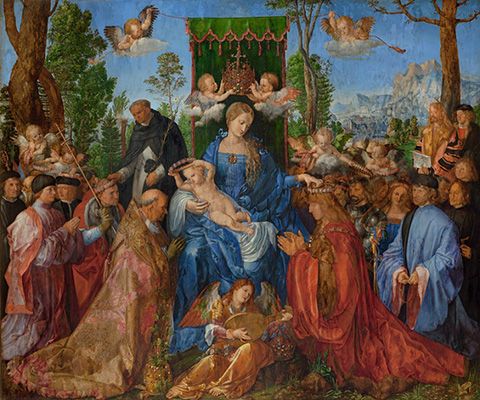Abhishek Dixit
Albrecht Dürer (1471–1528), a highly talented and adaptable artist from Germany’s Renaissance era, was born in Nuremberg, a prosperous European cultural and economic hub between the fifteenth and sixteenth centuries. Albrecht Dürer, a prominent figure of the Northern Renaissance, crafted exquisite works in drawing, painting, and printmaking. He played a vital role in facilitating knowledge exchange between the Italian Renaissance and the Northern Renaissance, forging valuable connections with Italian Renaissance representatives. Dürer received training as an apprentice under his father, a goldsmith, and Michael Wolgemut, a reputable painter. Under Wolgemut’s guidance, the workshop created woodcut illustrations for prominent books and publications. After marrying Agnes Frey, he promptly embarked on his initial journey to Italy.
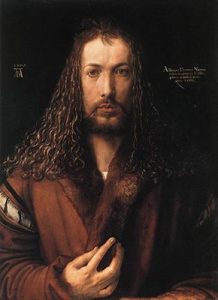
Courtesy: Google Arts & Culture
In subsequent years, Dürer redirected his focus toward producing prints, specifically woodcuts and engravings. He recognized printmaking as a distinct form of art and produced some of his most famous pieces utilizing this technique. Dürer, who was inspired by his fellow countryman Martin Schongauer, transformed the practice of printmaking and made it a distinctive form of art that stood on its own. With his innovative approach, he broadened the scope of his creation by introducing new tonal and dramatic elements and also gave his imagery a fresh conceptual basis. At thirty years old, Dürer had either finished or started three renowned collections of religious woodcuts. During the years 1513 and 1514, he created his most notable engraving, commonly referred to as his ‘master engravings’: Knight, Death, and the Devil (1513), as well. Two artworks created in 1514 are “St. Jerome in his Study” and “Melencolia I.” Although the three prints do not necessarily have a unifying concept or message, they are frequently regarded as interconnected. Nonetheless, these examples undeniably showcase Dürer’s supreme expertise in manipulating light and dark tones, as well as his mastery of the engraved line. Earlier printed works were not able to match the technical mastery, intellectual breadth, and psychological complexity of their writings.
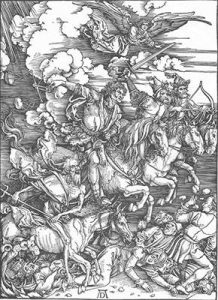
Courtesy: Google Arts & Culture
Dürer was significantly influenced by his journey to Italy, which is evident in the majority of his artworks in the ensuing decade, featuring both explicit and implicit references to Italian art. Dürer had the opportunity to view engravings by renowned artists from central Italy, possibly even prior to his visit to Venice. The artist’s primary sources of inspiration were two renowned Italian painters: the Florentine Antonio Pollaiuolo, known for his graceful and dynamic depiction of the human body in motion, and the Venetian Andrea Mantegna, who placed significant emphasis on the classical themes and meticulous delineation of human figures using precise lines. Dürer journeyed twice to Italy during his lifetime, where he gained a significant understanding of proportions, anatomy, and perspective. Afterward, he devoted a significant amount of time to disseminating his theoretical expertise, making it accessible to emerging artists through the publication of Four Books of Human Proportion. Dürer familiarized himself with the art of Gentile and Giovanni Bellini and assimilated the styles of Andrea Mantegna, Antonio Pollaiuolo, and Lorenzo di Credi through careful replication. Began in Venice, quite possibly due to Jacopo de’ Barbari, was his development of an acute understanding and enduring fascination with the theory of human proportions.
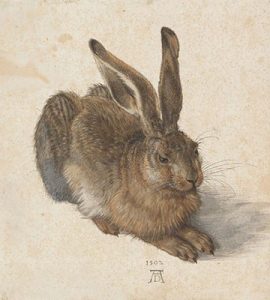
During this time, Dürer created paintings that were non-religious, had allegorical meanings, and often centered on himself. These pieces were either based on Italian art or completely original, embodying the independent and progressive nature of the Renaissance era. Dürer utilized the portrayal of Hercules taken from Pollaiuolo’s artwork, The Rape of Deianira, in creating his own masterpiece, Hercules and the Birds of Stymphalis. Dürer’s Hercules painting stands out among his other works, as it follows the Renaissance tradition and is purely centered around mythology. Dürer’s creation of the centre panel of the Dresden Altarpiece around 1498 exhibited a comparable style to Hercules and reflected Mantegna’s artistic influence. Dürer’s adaptations showcase a notable influence from the elder painter Giovanni Bellini, with whom Dürer had a connection during his time in Venice, contributing to a more lyrical style. Dürer’s progression towards the Renaissance mood is best depicted in a captivating self-portrait he painted during 1498. In depicting himself, Dürer aimed to express the aristocratic Renaissance values in a subtle manner. He enjoyed his appearance as a confident and stylish young man, confronting life with a hint of arrogance. Instead of using a typical, colorless and uniform backdrop, he chooses to present the setting as an indoor space complete with a window positioned on the right-hand side. A small-scale scenery consisting of mountains and a far-off ocean can be seen from the window, which bears a striking resemblance to modern paintings from Venice and Florence. The artist’s interior world is distinguished by his concentration on his own figure while the vast perspective of a distant scene creates a sense of connection to another world.
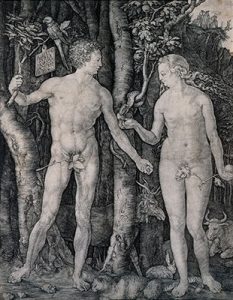
Dürer’s graphics were less affected by Italian influences compared to his drawings and paintings, with a slower adoption rate. The visionary woodcuts in his Apocalypse series, which depict the Revelation of St. John, are heavily influenced by the late Gothic style. The prints in this collection exhibit forceful depictions, intense sentiment, and often densely populated, occasionally overly packed, arrangements. The earliest woodcuts of Dürer’s Great Passion series, dating back to approximately 1498, were also influenced by the same tradition. Despite everything, the truth remains that Dürer’s shift towards a modern perspective, which was influenced by classicism and humanism, shows his fundamental Italian inclination. Until approximately 1500, his artistic technique alternated between Gothic and Italian Renaissance styles. After a period of restlessness, he finally found a clear path to pursue. In the year 1500, Dürer created a self-portrait that depicts him in a positive light, reminiscent of a Christ-like figure.
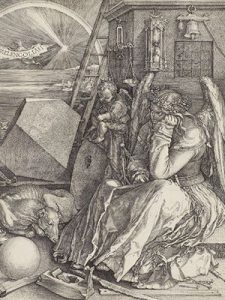
Dürer passed away on April 6, 1528, due to contracting a malaria infection back in 1521 when he visited Zeeland with the intention of witnessing a beached whale. Albrecht Dürer, a renowned German artist of the Renaissance, was widely recognized and often considered as the most remarkable artist of his time, whose work commanded great admiration and had a significant impact on the artistic movements across Europe. At times, even Dutch and Italian artists were not hesitant to replicate Dürer’s prints. Giorgio Vasari’s Lives of the Most Eminent Italian Architects, Painters and Sculptors regularly emphasizes the immense value and artistic mastery of Albrecht Dürer, demonstrating the widespread international recognition and reverence he held as a highly acclaimed painter and expert in copper engravings. Dürer, like other renowned Italian artists, likely considered himself to be a “monarch of the arts”, as evident from his self-portraits that exude his unwavering confidence in his artistic abilities.

Contributor

